In the past few years, there’s been a real transformation in the way people consume information and communicate. Fueled by the mass adoption of social platforms, this transformation in consumer behavior demands that the ways we market also evolve. This is especially true in business-to-business where brands compete in a content-flooded environment with countless information sources to capture buyers’ attention.
Author Archive for Ann Fottler-Pierce
Great Article from Top LinkedIn Exec on the Importance of Content Marketing
What is Branding and Marketing Strategy?
We hear the word BRAND a lot in association with big corporations such as McDonald’s™, Nike™ and Microsoft™. But what is branding really, and how can it help small to midsize businesses?

 A brand is not a logo or a tagline. It is much more. It’s the combination of your company’s image, products, personality and values. Brands serve as emotional triggers for customers looking to decide what to purchase. McDonald’s is the family-friendly restaurant that serves a quick, consistently good meal, “I’m lovin‘ it”. Jif is
A brand is not a logo or a tagline. It is much more. It’s the combination of your company’s image, products, personality and values. Brands serve as emotional triggers for customers looking to decide what to purchase. McDonald’s is the family-friendly restaurant that serves a quick, consistently good meal, “I’m lovin‘ it”. Jif is ![]() the peanut butter for choosy moms. Staples is the world’s largest office products company. They carry just about everything you could need and will even deliver it to your business. Their simple slogan is “That was easy”. They even have the easy button featured in their commercials for sale in their stores. Your brand is embodied in the look and feel of your facilities, in the behavior of your employees and in the tone of all your communications – intended or not.
the peanut butter for choosy moms. Staples is the world’s largest office products company. They carry just about everything you could need and will even deliver it to your business. Their simple slogan is “That was easy”. They even have the easy button featured in their commercials for sale in their stores. Your brand is embodied in the look and feel of your facilities, in the behavior of your employees and in the tone of all your communications – intended or not.
Every point of interaction between a company and its customers is an opportunity for its brand to be evaluated, either positively or negatively. Your customers are forming opinions and attitudes about your brand today that may last forever. You will usually get only one chance to capture a new customer, satisfy their needs (or better yet, exceed their expectations), and create a loyal customer who will give you repeat business and even recommend you to others – “the holy grail of marketing”! Your brand identity is as important as the product or service you sell. If someone is making a product choice where there is no obvious difference between the offerings, brand preference will win the day. If your brand has a stellar reputation you won’t have to compete on price to make the sale. Investing in your brand identity and increasing awareness of your brand is invaluable.
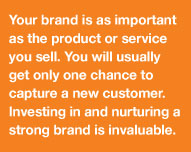 What can a Strong Brand Deliver?
What can a Strong Brand Deliver?
Having a strong brand allows your company to rise above commodity status. Strong brands thrive in good economies and weather slowdowns well. They are able to charge premium prices. They help attract great employees, business partners and customers. Strong brands capture market share, offer cross-selling opportunities, inspire customer loyalty and fend off competition. They are forgiven mishaps and increase bargaining power with retailers and distributors (for manufacturers). A strong brand can be worth its “weight” in gold.
A close cousin to branding is positioning. Positioning your company involves identifying and gaining an understanding of your target audience. Who are you trying to appeal to and how will you do it? Your target audience should not be everyone. You need to be more specific in order to spend your marketing dollars wisely. Disneyland tries to appeal to families by offering fun and friendliness through their tagline “The friendliest place on earth”. They are selling safe, fun, memorable family vacations and everything they say and do emphasizes just that. You won’t see them marketing to singles or seniors. They’ve identified their target audience and design everything they do to appeal to them.
Target audiences are usually chosen in one of two ways: demographically or behaviorally. Demographics involves identifying certain traits your prospects are likely to share: age, income, geography, job title, education, etc. One of the demographic profiles I targeted as a designer was marketing directors at mid-sized businesses in Southeastern Massachusetts. Behavioral targeting is more on the psychological/lifestyle side. You may need to contact women between 29-40 who are unsatisfied in their current career and are open to change. Maybe it’s men 18-30 who consider themselves trendsetters and must have the latest electronic gadget, no matter the cost. Your target will simply be the people you believe have the most potential to buy what you are selling.
Your brand’s positioning statement identifies this audience and states how you would like to be perceived by them. A women’s apparel shop may want to appeal to women between 22-35 with an average income of $50,000 or more. They may want to be perceived by these women as THE place to go for trendy, European-style clothing. Notice that they are not trying to appeal to women in general, just a select audience of profitable prospects.
Is Your Company Passionate?
Once you’ve defined your brand and positioning you need to know one more very important thing: the reason why anyone should care! What is it that you do differently from your competitors? What is your organization passionate about? Instead of classifying yourself as a generic financial planner, try saying “I create long-term, easy-to-follow investment plans for newlyweds” or new parents, or small business owners. Whatever it is that you really want to focus on, that you believe in, and that will bring you plenty of profitable clients. Don’t be afraid to be specific, no one can be appealing to everybody. If you narrow your audience you can concentrate your marketing budget on a smaller, more interested target.
Let’s use the male trendsetter as an example. If our company is an electronics store we could appeal to this target by having a special spot on our web site where these early-adopters could post reviews of the products they buy from us and gain a following among later shoppers who read and vote on the accuracy of the reviews. This would appeal to their interests, boost their ego and increase their loyalty to our store/brand, all by being a little unique.
Although we may hate to admit it, most of what competing companies do is the same. They all strive for good management and customer service and price themselves competitively. They all try to offer quality products or services that people will want. Performing well is just how a company stays in business. It is not unique. It’s what you do differently from the competition that constitutes your Unique Selling Proposition (USP) and that’s what you’ll base your strategy on.
A USP is a relevant and compelling reason why prospects should choose you over the competition. It can’t be a temporary situation such as a sale or special offer. It shouldn’t be generic like “great customer service”. It needs to differentiate you from your competitors in the minds of your target audience and make you the natural choice for them to make.
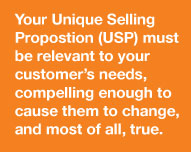 Some companies find their Unique Selling Proposition by deciding to focus on an under-served niche in an otherwise crowded market. Nokia, for example, was the first to treat cell phones as a fashion accessory with changeable faceplates. Fashion-conscious consumers responded enthusiastically and this innovation took off. They used style as a USP to stand out in the glutted consumer electronics market when everyone else was busy hyping tech features. That’s differentiation.
Some companies find their Unique Selling Proposition by deciding to focus on an under-served niche in an otherwise crowded market. Nokia, for example, was the first to treat cell phones as a fashion accessory with changeable faceplates. Fashion-conscious consumers responded enthusiastically and this innovation took off. They used style as a USP to stand out in the glutted consumer electronics market when everyone else was busy hyping tech features. That’s differentiation.
Have you seen the new Dutch Boy® paint containers? Someone at Dutch Boy saw that traditional paint cans are just plain annoying! Why were all the paint manufacturers using this terrible packaging? Habit, tradition, nothing more. They used this design flaw to introduce an easy-to-use plastic paint jug. Sales went way up, and Dutch Boy got more distribution at higher retail prices. They created a USP by changing the customer experience with their product, not the product itself. Pretty smart. Can your company dig into the customer experience in your industry and come up with a key insight that would make you the obvious choice among prospects? It’s definitely worth a try.
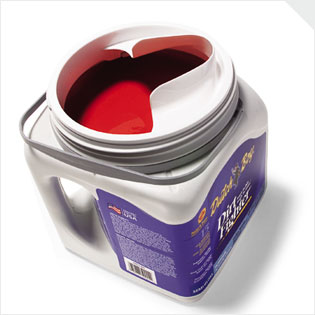 You don’t have to have a revolutionary idea; the point is that you must have a way to stand out from the crowd. You need to give people a reason to choose you. What are some of the reasons current customers enjoy doing business with you? Are you easy to use, have more efficient processes, supply truly unique technology? You can take any of these concepts and turn it into your USP. But, remember, it must be relevant to your customers’ needs, compelling enough to cause them to change, and most of all, true. Once you’ve found your USP, don’t keep it hidden. Get it out there where it can be seen on a consistent basis by your target audience.
You don’t have to have a revolutionary idea; the point is that you must have a way to stand out from the crowd. You need to give people a reason to choose you. What are some of the reasons current customers enjoy doing business with you? Are you easy to use, have more efficient processes, supply truly unique technology? You can take any of these concepts and turn it into your USP. But, remember, it must be relevant to your customers’ needs, compelling enough to cause them to change, and most of all, true. Once you’ve found your USP, don’t keep it hidden. Get it out there where it can be seen on a consistent basis by your target audience.
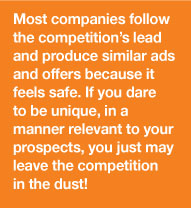 Fear of Uniqueness
Fear of Uniqueness
It can be scary to be unique. Most companies follow the competition’s lead and produce similar ads and offers. It seems safe, but it actually assures that you’ll never overtake the competition; that takes innovation and daring. Unless you have an effective strategy and a unique message, it doesn’t matter how many brochures you send out or how many salespeople you hire. You won’t get the results you need to move your business forward. If you dare to be unique, in a manner relevant to your prospects you just may leave your competitors in the dust.
A Cost-Effective Way to Reach Your Target Audience
Email marketing is a great way to communicate with both current and potential customers. A well-crafted campaign is cost-effective, quick to execute, builds relationships and provides timely and detailed feedback you can use to boost sales.
You can use email to do just about any kind of advertising you would normally do; advertise a new product, a sale, service, charitable fundraising, etc. What email offers that traditional media doesn’t is the potential for immediate interactively. Your recipient is already right there at the computer. They’re just one click away from your site and making the critical connection to you. Toll-free numbers, pre-paid reply cards, or web site addresses just don’t compare to the immediacy of a link in an email. Nothing is easier than just clicking right now!
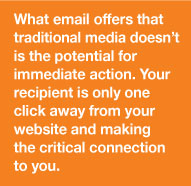 Xtreme Brand Makeover is a Constant Contact Partner
Xtreme Brand Makeover is a Constant Contact Partner
As a Constant Contact Business Partner, we can offer our clients the impact and measurable results of the global leader in email marketing. It’s a solution that makes sense for any client budget or economic outlook.
Custom Email Templates & Newsletters
From member newsletters to money-saving promotions—whatever message you need to communicate, we’ll design a custom template for it. Each template offers complete flexibility—with just a click, add your product photos, offers, articles, links, promotions, coupons, and more. Not sure what to say? Read our article on Email Marketingfor tips and suggestions. Or have XBM create powerful, effective content for your business—making Email Marketing even easier for you!
Email List Management
What’s the best list for your business or organization? A permission-based one. That means everyone on it said it’s okay for you to contact them. It’s better than a mailing list you buy or rent, because you already know the people on your list want to hear from you and are interested in you. It doesn’t cost you anything to build one. We’ll help you start one—and keep it growing too.
Start and grow your permission-based mailing list
- Add our “Join My Mailing List” button to your website to collect visitors’ email addresses
- Add our “Forward-to-a-Friend” link in your email campaigns to reach new people
- Our SafeSubscribe™ and SafeUnsubscribe™ features increase your new sign-ups: They assure new contacts that it’s easy to remove themselves from your list if they change their minds
Import your existing list the way you want
- Type or copy and paste your email addresses into your Constant Contact database
- Easily import your permission-based file: Excel (.xls), comma separated value (.csv), and text (.txt)
- Import effortlessly from Microsoft Outlook®, Outlook Express®, QuickBooks® by Intuit, Salesforce.com and ACT!® by Sage®
Group your contacts into targeted email lists for powerful results
- Segment based on interest or shared characteristics (like location or birth month)
- Combine multiple email lists into a new, single email list when you need one big mailing. We even make sure people on multiple lists only get one message
Keep your list up-to-date, and reliable
- You can access and update your contact database from any computer, whenever you want
- Our SafeUnsubscribe form asks contacts why they leave, so that you can make changes to improve retention
- Let contacts choose which email communications they want to receive from you
We’ll help you build your list of loyal customers!
Get your email in their inbox Constant Contact’s deliverability rate is consistently over 97%. We keep our relationships with internet providers strong and offer content-scanning tools to get your message straight to your contact’s inbox – not a SPAM filter.
Our delivery maximization tools help get your email campaigns to the inbox
- Anti-Spam Checker spots possible trouble in your emails and suggests changes
- Constant Contact’s templates are format-tested in most email programs to ensure that the email you send — whether HTML or text — is the email your customers see
- Constant Contact Email Authentication assigns you a unique domain name that’s tied to each email you send, so your emails are not grouped in with those of other customers
Track your results
See who’s reading your emails and clicking on your links in real time, and track the performance of all of your Email Marketing communications over time.
Email Marketing Tracking and Reporting
One reason why we’ve chosen to partner with Constant Contact is their ability to track what happens after you click “Send.” Just log in to your account to see who read, who clicked, and who forwarded your email to their friends, and more. We’ll tell you with easy-to-understand reports.
View who opened and clicked through your email
- See what percentage of your email marketing list opened your email, and who they were
- Check which links generated the most click-throughs and interest
- Measure the performance of your email campaign
Compare results from all your email campaigns
- See side-by-side email campaign statistics — open rate, bounce rate and click-through rate
- Compare your results to those of other Constant Contact customers in your field or industry
- Print out each email campaign report to review at your convenience
Watch your email list grow and track opt-outs
- Learn when a new contact signs up
- See how many people forwarded your emails to friends
- Track your monthly list growth by source — like through website traffic, forwarded emails, in-store signups
- Learn who unsubscribed from your email list, and why
Manage bounced email addresses
- See which email addresses in each campaign bounced
- Learn why they bounced, then contact your customers to find out why or update your database
- Remove or edit them as needed for your next campaign
Direct Mail – Still Important to Your Marketing Mix
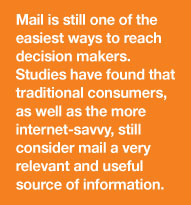 What is one of the first things you do when you get home at the end of the day? I bet you get the mail! It’s part of almost everyone’s daily routine. Mail is still one of the easiest ways to reach decision makers. It’s tangible, portable and can be read at the prospect’s convenience. An email has to get past spam filters and actually get opened to be effective. Direct mail goes right to the mailbox and can start the sales message on the outside of the envelope or on the front of the postcard. Direct mail is also great for driving traffic to your web site and gathering opt-ins for your email campaigns.
What is one of the first things you do when you get home at the end of the day? I bet you get the mail! It’s part of almost everyone’s daily routine. Mail is still one of the easiest ways to reach decision makers. It’s tangible, portable and can be read at the prospect’s convenience. An email has to get past spam filters and actually get opened to be effective. Direct mail goes right to the mailbox and can start the sales message on the outside of the envelope or on the front of the postcard. Direct mail is also great for driving traffic to your web site and gathering opt-ins for your email campaigns.
Studies by the United States Postal Service (USPS) and other independent groups found that traditional consumers as well as the more internet-savvy still consider mail a very relevant and useful source of information. People enjoy the physical aspect of viewing mail and many prefer it to email communication and telemarketing. Studies also showed that combining mail with online efforts can have a substantial impact on web site traffic. Using these two tactics together will definitely improve your results.
Direct mail is an effective tactic, but, just like an email inbox, your customers’ mailbox gets pretty full as well. So you’ll need to stand out here too. Some ways to accomplish this are:
Teaser Copy.
Why send an envelope with just address information on it? Why not use that valuable real estate to start the sale at first glance? Try using headlines that will engage your audience…”Do you know the 5 steps to…” or appeal to their curiosity “Find out why so many of your colleagues…”. If you already have a relationship with this prospect make sure to call that out. Even printing a line on the back of the envelope lifts open rates.
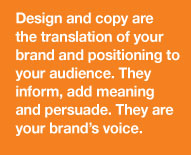 Stand Out.
Stand Out.
Did you know that 3/4 of all envelopes that are mailed are 24 lb., white, #10 size? Dare to be different, it will pay off. People will open an intriguing envelope. Try a #12 envelope, or one with bubble pack, or unconventional sizes and colors. You’d be surprised what can be mailed. People have mailed barf bags, anti-static bags, burlap bags, even a life-size cardboard cutout of Elvis. Just be sure to bring a test piece to the post office first to avoid any surprises.
Catalogs
Even though people do a lot of their buying online, catalogs are still crucial to selling merchandise. Alone they are a great vehicle to show your products, but when combined with online efforts their effectiveness only grows. Catalog mailings can be highly targeted with the right mailing list and the ROI is very measurable.
The USPS estimates that 37% of e-commerce dollars come from catalog recipients. 41% of Americans shop using both catalogs and the internet (I know I do), and in your target audience the percentage may be even higher. Even retailers that started solely as online stores such as Amazon.com, Ebay and RedEnvelope have used catalogs to gain more sales online. They know that mailing catalogs helps attract new, profitable customers.
Postcard Campaigns
They may have less real estate for your message than an envelope mailing, but you don’t have to worry about people not opening them. They are also very easy for people to save or pass on to another interested party. Try an oversized postcard or a die-cut shape to stand out.
Interactive Mail
These include zip-pull envelopes, scratch-off cards, sticky notes, stickers, etc. The longer a person interacts with your mail piece the more message retention and response it will generate.
Dimensional Mail
This type of campaign can triple response rates and message retention. The cardboard Elvis mailer would be a dimensional piece. Other examples would be sending a premium gift – mailing a sports water bottle with a letter inside, or one walkie talkie with an offer to have the other delivered by your sales rep when the prospect responds. If you’re trying to reach executives you must remember they get a huge amount of unsolicited mail, which is then sorted by an assistant. An important or valuable-looking package is never thrown away like a generic DM piece; it makes its way to your intended recipient. As long as you have a great strategy and message, once your mailer is opened, you should hit your sales goals.
Personalization
Variable Data Printing technology has come a long, long way. It used to be cool just to inkjet the recipient’s name in the mail piece. Now, you can go far beyond that. New digital presses can change the text and even the imagery of your piece based on each recipient. It’s even possible to automatically generate unique URL’s (web addresses) that can be printed on each piece, putting a prospect’s name right in the web address of your site’s landing page. Smart use of this personalization technology can raise the response rate of a campaign by up to 450%. If a 2% response rate is good, an 8% rate is exceptional! Personalization will increases the cost of your campaign, but the increase in response usually more than makes up for the added expense.
Get the Right Mailing List
Your list accounts for 40-50% of the campaign’s success rate. If your budget is extremely tight target your list more specifically so you can spend more per person. It’s more important that your piece stands out in the mailbox than that it goes to more people only to be ignored by them because they are the wrong people. When you have a quality, highly targeted list it’s safe to assume that many non-responders may actually still be your best prospects. That’s why smart direct mailers will keep mailing to the same list over and over, they get more responses the more they are seen by the same people.
Segmentation
All prospects are not the same, some will be more profitable than others, so spend accordingly. Segment your prospects and try a concept that can be executed on two different cost levels. Maybe one is an elaborate envelope with variable data printed material inside that is sent to prospects your research shows will be more valuable. Then re-purpose the printed material without VDP for a simpler mailer for prospects that are likely to be less profitable.
Make it Easy
Everybody has their preferences so give people multiple ways to respond to your campaign; web site, physical address, response card, toll-free number, etc.
 Don’t Skimp on Execution
Don’t Skimp on Execution
Using full-color printing makes your piece much more attractive and pulls higher response rates. The cost of 4-color printing is very affordable these days due to new technology and heavy competition in the industry. If you are mailing to a small list try a printer with a digital press. You’ll get 4-color output on small runs for a very reasonable cost.
Fulfillment
If you are a small business and only have a few hundred prospects you may feel comfortable handling your own mailing. But most businesses will need professional fulfillment help. Mailing is a complicated business. Drop dates, postal rates and regulations, conforming to postal automation techniques, personalization software programs, all these issues can best be addressed by using a printer or mailing company that is extremely familiar with the industry and it will save you money in the long run.
When is a Press Release not just a Press Release?
Answer: When it’s posted on the internet.
The internet seems to have changed every aspect of marketing and communications. Even the stale, old press release has been transformed by it. It’s become a marketing powerhouse and you should be taking advantage of it.
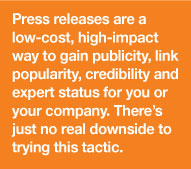 Press releases used to be written to appeal to the editors of the publications you were praying would run the release. You often had to include third party reviews or independent studies of your product or service in order to get published. The internet has completely changed that scenario.
Press releases used to be written to appeal to the editors of the publications you were praying would run the release. You often had to include third party reviews or independent studies of your product or service in order to get published. The internet has completely changed that scenario.
Now marketing departments and business owners can release their information directly to the public on their own web sites. They can also submit them to services that will spread them far and wide over the internet. Even editors and journalists now look to the web first for new stories that they will publish in print or on content-driven web sites. Your press release can now focus on pleasing the end reader, not just the editors.
There are several good reasons for using press releases as a part of your marketing strategy:
• If someone is taking the time to research your industry they could be a potential customer, you don’t want them to miss you.
• Posting your press releases on your site gives you instant credibility with visitors.
• To provide content for journalists searching for new information about your company or industry. They may choose to write about it, either for a web site or print publication. Either way, it’s free advertising for you!
• Posting your press releases to your web site gives you a source of new content, and this is very important to search engine page ranking. Your release should be in a searchable format and keyword-rich. Many companies find that their “News” page is one of the most visited pages on their site. Make sure it has quality content.
• If you’re using an online press release service (and you should) make sure to include live links in your text directing people right to your site or offer. That way, when people come across your release in a search, they can go directly to your site for more information.
• Putting these live links directly in the text of your press releases serves another important purpose – raising your link popularity. Your site’s page rank in search engines like Google (how deep your site is when someone searches for your category/product) is largely dependent on incoming links to your site. This is called Link Popularity.
All these press releases floating around in cyberspace will be incoming links. People reading your release may put a link to your site on their site as a resource for their readers, giving you more incoming links. This particular aspect of Search Engine Marketing is cheap and very effective in raising your page rank.
So, when should you issue a press release?
Anytime something of note happens at your company. When you introduce a new product or service, win an award, hire a key new employee, publish a white paper, conclude a study or survey, launch a new web site, sponsor a workshop or land a big new client (with their permission). Issue a press release anytime you have something to say that your target audience may find interesting. Be sure to archive your older press releases on your site in a searchable format for as long as the content seems relevant.
Use a journalistic style when writing your release; avoid seeming too promotional. Use keywords and phrases in the title, headlines, subheads and text that people are likely to use as search terms on Google or Yahoo. Stay away from corporate jargon and acronyms, they may be popular around the office but if they aren’t widely known by your audience they won’t help your effort.
You can post your releases directly to your site’s News section, but you should also consider using some press release services to get the word out. These are some of the most popular services:
PRWeb www.prweb.com
MarketWire www.marketwire.com
BusinessWire www.businesswire.com
PRNewswire www.prnewswire.com
Compare the various services and decide which one will be best for reaching your target audience. Most of these services also offer RSS feeds for your releases. This will make your information available to content-driven sites, blogs and individuals who have interest in your offerings. How can you beat that?
Keeping an eye on the publicity you’re getting is always a good idea. Try using a Buzz Monitoring Service – Services that will email a client regarding their status in an industry. Most of these publicity monitoring services will email anytime a company’s name, executives, products, services or other keyword-based information on them are mentioned on the web.
Google Alerts (google.com/alerts)
Yahoo! Alerts (alerts.yahoo.com)
CyberAlert (cyberalert.com)
Carma (carmainternational.com)
Some services charge a fee; others, such as Yahoo! and Google Alerts, are free.
 Now that you’re taking advantage of the internet, don’t forget the traditional approach. Submit your press release, a one-page company profile and owner/CEO biography to traditional print outlets such as newspapers, relevant magazines and trade journals. Tell them why your press release will be interesting and relevant to their audience. They may publish your release or, if you’re lucky, write an article about your company.
Now that you’re taking advantage of the internet, don’t forget the traditional approach. Submit your press release, a one-page company profile and owner/CEO biography to traditional print outlets such as newspapers, relevant magazines and trade journals. Tell them why your press release will be interesting and relevant to their audience. They may publish your release or, if you’re lucky, write an article about your company.
There’s just no downside to trying this tactic. Press releases are a low-cost, high-impact way to gain publicity, link popularity, credibility and expert status. You should consider making them a regular part of your Multi-Marketing Strategy.
Over 800 million unique users visit YouTube each month.
200,000,000+ estimated number of blogs worldwide.
Over 800 million active users on Facebook.
175,000,000 log on to Facebook at least once a day.
140 million active Twitter users. 340 Million Tweets per day.
Social Media is the new buzz word in marketing circles, but what does this phrase really encompass. Ask 10 different people and you may very well get 10 different answers that overlap each other in several places.
____________________________________
Wikipedia defines Social Media as:
“Social media is content created by people using highly accessible and scalable publishing technologies. At its most basic sense, social media is a shift in how people discover, read and share news, information and content. It’s a set of technologies, tools and platforms facilitating the discovery, participation and sharing of content. It is transforming monologues (one to many) into dialogues (many to many) and the democratization of information, transforming people from content readers into publishers. Social media has become extremely popular because it allows people to connect in the online world to form relationships for personal and business. Businesses also refer to social media as user-generated content (UGC) or consumer-generated media (CGM).”
“Social media can take many different forms, including Internet forums, weblogs, social blogs, wikis, podcasts, pictures and video. Technologies include: blogs, picture-sharing, vlogs, wall-postings, email, instant messaging, music-sharing, crowdsourcing, and voice over IP, to name a few. Examples of social media applications are Google Groups (reference, social networking), Wikipedia (reference), MySpace (social networking), Facebook (social networking), MouthShut.com yelp.com (product reviews), Youmeo (social network aggregation), Last.fm (personal music), YouTube (social networking and video sharing), Avatars United (social networking), Second Life (virtual reality), Flickr (photo sharing), Twitter (social networking and microblogging), Open Diary (blogging), and other microblogs such as Jaiku. Many of these social media services can be integrated via social network aggregation platforms like Mybloglog and Plaxo.”
_________________________________________
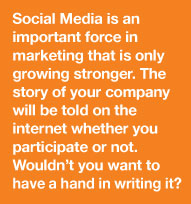 What is included in the definition tends to vary, but there’s little debate over its increasing popularity and relevance to marketing executives. Consumers are sharing their thoughts and experiences on every brand and product you can think of on forums, blogs and networking sites around the world. They are rating products, writing their own reviews on sites like Amazon.com and other consumers are listening. This online word-of-mouth is an ever-increasing factor in what consumers decide to purchase and participate in. It’s effect on the way people make purchasing decisions is only going to increase.
What is included in the definition tends to vary, but there’s little debate over its increasing popularity and relevance to marketing executives. Consumers are sharing their thoughts and experiences on every brand and product you can think of on forums, blogs and networking sites around the world. They are rating products, writing their own reviews on sites like Amazon.com and other consumers are listening. This online word-of-mouth is an ever-increasing factor in what consumers decide to purchase and participate in. It’s effect on the way people make purchasing decisions is only going to increase.
Many businesses are harnessing Social Media as a new channel to market to potential customers. Webinars, blogs, customer forums and podcasts are just a few ways to get into the Social Media Marketing mix.
______________________________________
Wikipedia defines Social Media Marketing as:
“…In the context of Internet marketing, Social Media refers to a collective group of web properties whose content is primarily published by users, not direct employees of the property (e.g. the vast majority of video on YouTube is published by non-YouTube employees). Social media optimization (SMO) is a set of methods for generating publicity through social media, online communities and community web sites
Social media marketing has two important aspects. The first, SMO, refers to on-page tactics through which a webmaster can improve a web site for the age of social media. Such optimization includes adding links to services such as Digg, Reddit and Del.icio.us so that their pages can be easily ‘saved and submitted’ to and for these services.
Social media marketing, on the other hand, is about building ways that fans of a brand or company can promote it themselves in multiple online social media venues…”
“…The premise of social media marketing is engaging with the consumer and providing value. It is important to maintain the sanctity of conversational economy..”.
_______________________________
Before You Enter The Social Media World
It is tempting to dive right in to Social Media when you start finding relevant sites and blogs. But, it is always better to have defined a set of objectives you wish to reach as well as a list of tactics for getting there. These objectives and tactics will probably change and evolve as you go about your plan, but it is important to have a clear starting point at the beginning to work from. This will avoid a lot of wasted time and effort on your part.
Objectives
Are you trying to drive traffic to your site? Generate qualified leads for the sales team? Create buzz around a product launch? Become a known expert in your field? There are any number of reasons you may want to launch a social media initiative. Your reasons will determine which tactics you should use. But, once you’ve chosen them, how can you measure their effectiveness?
Web Analytics can track your page views over time to see if there are spikes or general increases in traffic when you post to blogs, leave comments or otherwise engage in social media. You can track the amount of RSS subscriptions your blog is getting. You can even track inbound links from others to your site or pages. Use Google Alerts to tell you when and where you or your company are being mentioned on the web. These are just some of the ways to get a handle on ROI in the Social Media world.
Basic Forms of Social Media
Social Networks –
These sites allow people to sign up and build their own personal profile or webpage with their own content, sometimes including pictures, videos, links to other sites and more. Users can then connect with friends in the network to share their profile or invite outside friends to join. Examples include: LinkedIn, MySpace and Facebook.
Social Media Release / Online Newsroom
These tactics represent more than just a regular press release or recent news section of a web site. They are press releases that include rich media such as photos (high resolution for print media, low resolution for web sites), audio, video, animation, bookmarks or other social tools. Posting these to your online newsroom provides readers and journalists with great content to link to, share, or use to write articles about your company easily.
Social Calendars
These are tools that allow people to find and share events that relate to a specific category or interest. They can be live events at a specific location, or online events such as webinars or video releases. You can monitor social calendars about your industry to see what prospects and competitors are doing or even launch your own to make your site a more valuable resource in the industry.
Wikis –
These web sites are all about collaboration and user input. They allow users to add content and/or edit the information on them. The best known of these is Wikipedia, the online encyclopedia.
Videos
Videos can be produced and placed on your site and on sites such as YouTube. Be sure to tag your videos with the keywords you believe your target audience will use to search for such content. Produce them for product demos, training, lectures or any topic you think may be of interest.
Examples include: Veodia, UStream, Kyte, BlogTV, Veotag.
Podcasts –
These are audio and video files made available by subscription on sites such as iTunes. Users can download them and view them at their convenience. Businesses can produce a podcast to mark a company milestone, share case studies, executive interviews and more.
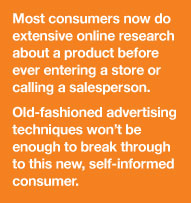 Webinars
Webinars
Webinars are used to conduct live presentations via the Internet. It is typically one-way, from the speaker to the audience with limited audience interaction. A webinar can be collaborative and include polling and question & answer sessions to allow full participation between the audience and the presenter. In some cases, the presenter may speak over a standard telephone line, pointing out information being presented on screen and the audience can respond over their own telephones. There are web conferencing technologies on the market that have incorporated the use of VoIP audio technology, to allow for a truly web-based communication experience.
These online broadcast are great for lead generation and brand awareness. People sign-up to view your webinar at a specific time live, or to view a previous one archived on your site. Consider producing a webinar to introduce a new product, solve a common industry-related problem, discuss an important industry issue, any topic that will be relevant to your target audience. It is important to provide informative and useful information to your viewers. They are “attending” to learn, not to view a hard-sell commercial for your product or service.
Forums –
The oldest form of online social media are forums – online discussion sites, often organized around a specific topic or area of interest such as coin collecting, music and software applications. They can be self contained or exist as a feature in a web site. Unlike a blog, forum content comes from its users who post questions and receive answers from other forum members. To find forums in your area of interest try the forum search engine Board Tracker.
Content Communities –
These communities exist to share a particular type of content such as popular bookmarks, photos or videos. As in social networking sites, you register and receive a homepage, then you upload the content you want to share. Examples include: Flickr (photos), YouTube (videos), Digg (news) and del.icio.us (bookmarks).
Content sites usually allow tags or tagging – users can attach keywords to label content in order to help others organize and search through it.
Social Bookmarking
A method for Internet users to store, organize, search, share and manage bookmarks of web pages on the Internet.
In a social bookmarking system, users save links to web pages that they want to remember and/or share. These bookmarks are usually public, but can be saved privately or shared with only specified groups. These bookmarks can usually be viewed chronologically, by category or tags, or via a search engine. Some social bookmarking services also draw inferences from the relationship of tags to create clusters of related tags or bookmarks.
Many social bookmarking services provide web feeds for their lists of bookmarks, including lists organized by tags. This allows subscribers to become aware of new bookmarks as they are saved, shared, and tagged by other users.
As these services have matured and grown more popular, they have added extra features such as ratings and comments on bookmarks, the ability to import and export bookmarks from browsers, emailing of bookmarks, web annotation, and groups or other social network features. Allowing users to easily bookmark your web site, forum or blog will help you gain visitors and popularity.
Blogs –
One of the most well known and widespread social medium, blogs are online “journals” with entries appearing in chronological order, often archiving old entries. Many blogs allow the posting of comments that give them great interactively with users.
Although most blogs are not revenue generators there are a growing number that are. These blogs are actually businesses employing writers to generate content and accepting advertising targeted to their reader demographics.
You can use Google Blog Search or Blog Pulse to find blogs covering the topics you are interested in. When you do find a blog that suits you check out its Blogroll – a list of recommended related blogs. Now you’ll have many to choose from to find the ones that are right for you.
Microblogging –
Like its name suggests, microblogging involves small posts of content or updates that are distributed online as well as through a mobile network. These posts are also available through RSS subscriptions. Think of it as a combination of blogging and instant messaging. Many news sites are using microblogging and it was also part of the Obama ‘08 campaign strategy.
Example: Twitter, Jaiku, Tumbler
Mashup
A mashup is a digital media file that contains any or all of the following: text, graphics, audio, video and animation, drawn from pre-existing sources, to create a new derivative work. Digital text mashups, for example, appear by the thousands every day as users of blogs and forums copy and paste text in posts and comments on their topics of interest. Video/audio mashups are a major portion of YouTube’s content.
Collage Tools
These online tools allow you to create your own mashup by integrating many different types of content into a single, portable format. These streaming “channels” can include photos, video, audio, text, RSS feeds and more. You can then place your collage or mashup on your web site, blog or social networking page where others can experience them.
Examples: Sprout.com, SplashCast
Using Social Media to Your Advantage
Social Media initiatives require a drastically different approach from that of traditional media. You can’t just enter a forum and start broadcasting you USP or mission statement hoping that people will respond. They will respond…negatively that is. These savvy users don’t tolerate spamming or hard sell content. Consumers are there to share information and opinions, their cynical and tired of being blasted 24/7 with advertising messages. They want useful information from their peers or from experts in a particular field. So, give it to them. Don’t think of it as another advertising campaign but as a two-way conversation with potential customers. Be sure to be honest about who you are and who you represent and you’ll gain respect.
When identifying where on the web to participate in social media don’t guess or take a shotgun approach. Ask your current customers what online sources they use. Research where and what is currently being said about your company and/or industry. Companies like BuzzLogic allow the tracking of keywords and phrases on blogs and social media sites. You can also take advantage of Google Alerts, alltop.com – an online magazine rack of popular topics, compete.com – tracks traffic on web sites, to find the right places to begin.
Spend significant time monitoring these sites to learn the tone and attitude of users before you join in the conversation. Once you do begin start slowly, putting out content and comments that are valuable to your target audience. You’re not just communicating with active users, your content is also being read by “lurkers”, people who read the sites content but don’t actively participate in conversations. These “lurkers” far out number active users.
Use social media to your company’s advantage. Everyone involved in the initiative should see themselves as a brand ambassador, so make sure they are all on the same page as far as positioning, goals and attitudes. Remember, in all social media situations you want to be seen as informative, positive, honest and helpful.
Ongoing participation by your brand ambassadors is extremely important to your success. Long-term, meaningful involvement in a network will get you the kind of online reputation you’re looking for. Everyone involved should meet regularly to discuss current activities, results and future opportunities. This kind of initiative will have a positive effect on your search engine ranking as the fresh content, comments, trackbacks and incoming links all count in your favor.
Conclusion
Many businesses have shied away from Social Media for fear of negative comments or feedback. Yes, if you start a product forum or blog on your web site you may see some negative content sometimes. But it is better to know what customers really think of your company and products, and to address it in a positive, helpful way, than to remain ignorant of their opinions and problems.
Social Media is an important force that is only growing stronger, much like the internet itself. The technology and applications are ever-changing but the opportunity for marketing your product or service remains the same – opening relevant, honest conversations with existing and potential customers to drive brand awareness and sales. The story of your company will be told on the internet whether you participate or not. Wouldn’t you want to have a hand in writing it?
Why a High-Quality Web Site is an Absolute Must!
More and more people are turning to the internet to get information on the products and services they need. Web sites are becoming the most important touchpoint you can have with potential customers. Your site should not just measure up to the competition’s, it should be a well-organized, information-packed, lead-generating machine.
13 things you need to know to make your site more effective.
 1. First Impressions – Your Brand
1. First Impressions – Your Brand
Potential clients form their initial opinion of a company based on its web site. A professional look, relevant content and ease of use are essential. Is the site up-to-date with the latest news and info? Is the company attentive to detail? Poor grammar, typos and broken links give a bad impression that is hard to overcome. Is the company up to my standards? If it’s not they are gone in 10 seconds or LESS. Only when a prospect forms a favorable first impression of a site will they go on to evaluate the company’s offerings. This is where your branding, strategy, design and USP reel them in.
2. Offline and Online Marketing
All of your print ads, direct mail pieces and promotions should be driving prospects to your site. They should contain a compelling Call-to-Action directing them to your site for more details, etc. You should go a step further by using a unique web address or landing page for each marketing campaign. It helps you measure the effectiveness of each effort and actually raises success rates for campaigns. Techniques like this will help you refine your marketing efforts, making them more profitable.
3. Relevance
Now that your offline marketing is driving qualified prospects to your site, your core message and content must be seen, found relevant and remembered! You know from your own research on the web that you’ll probably visit several sites to gather information, but there’s always that one that you keep going back to that seems to address all your questions in a well organized and attractive manner. That’s the kind of site you want to have.
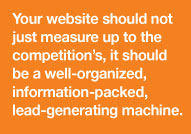 4. Lead Generation
4. Lead Generation
Determine who the primary visitor to your web site is and make sure they can quickly and easily get what they want. When a consumer goes to your site you want them to take action. This may include signing up for a free newsletter, a consultation, registering for an event, requesting a brochure or inquiring about a purchase itself. A well written and designed web site will help elicit these actions and is a necessary step to convert someone from a web site visitor into an actual customer. Talk to your sales force. Find out what your prospect’s typical preliminary questions and obstacles to buying are. Your site should address these up front to help pre-qualify leads and convert visitors into buyers. Raising your conversion rate from just 1 to 2 percent is the same as doubling your web site traffic, and it is usually much easier and cheaper to do.
 5. Don’t just Regurgitate your Brochure onto the Web
5. Don’t just Regurgitate your Brochure onto the Web
Visitors will expect a greater benefit if they take the time to check out your web site. A good web site uses compelling and succinct text, interactively, intuitive navigation systems, etc. Everything on a landing page must be designed and written to entice a visitor to click. Using active words such as “Learn”, “Ask”, “Browse”, “Sign up” encourages your visitor to explore your site. Use “you” and “your” to keep your focus on the prospects needs; avoid “we” and “our”. Keep copy short and use descriptive links to pages that have more information. Remember, you just want to engage them so they make that first click and start exploring what you have to offer.
People read text on web sites very differently than they do text on a page. In fact they rarely read at all, they scan. Studies have shown that people pay the most attention to headlines and subheads when viewing a web site. So make sure these two important pieces of your copy engage visitors. Bullet points and photo captions are also popular with scanners so pay special attention to them as well.
Include keywords your prospects are likely to use in internet searches right in the headline and page title and put the keyword as close to the beginning of the headline as you can. By doing this you assure visitors that they are on a relevant site. It also favorably effects your site’s search engine ranking.
Try not to sound like an ad. Highlight benefits rather than features. Talk about how your product solves problems and make an emotional connection with the prospect. Make your headlines easy to read. For example, instead of “Brand X delivers unprecedented storage density, industry-leading scalability and unrivaled performance!” try “Three easy steps to truly secure data!” By testing different headlines and tracking results you will see which ones lead to actual sales and which ones cause people to leave your site without making an inquiry or purchase.
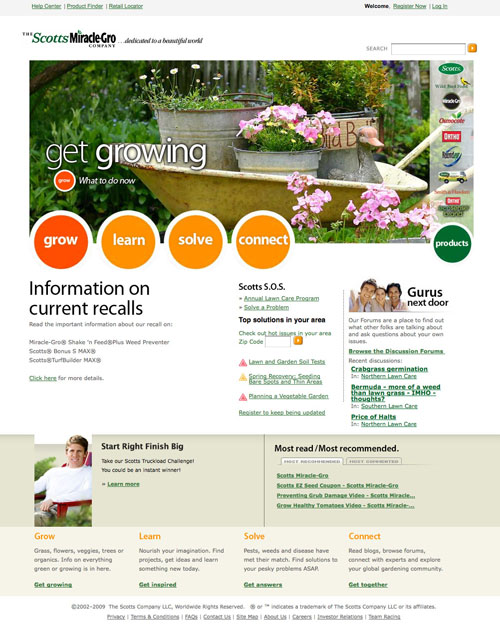 6. Images are Great but don’t forget the Web site Copy
6. Images are Great but don’t forget the Web site Copy
Many businesses put too much emphasis on their web site’s graphics and fancy Flash animations, but then don’t have enough text to back it up. Although on an initial visit people will just scan headlines and subheads, when they find a site they like, informative text will assure them of your competence and provides excellent content for search engines to evaluate when ranking a site (see Search Engine Marketing). You want your graphics to capture their interest, then your copy must satisfy their need to know. If you anticipate and answer the questions and concerns they have you will earn their trust and loyalty. Think like a prospect and ask yourself, “What would I need to know if I were in the market for this product or service”? Thinking this way will change the way you write and organize your content. The Scotts Company improved their web site by changing the entire way it was organized. The previous version was organized around Scotts corporate structure and various divisions within it. Not very user friendly for someone looking for a product to help them grow better tomatoes. The new site is designed with the customer in mind. It’s vibrant, inviting and informative, a resource customers will return to again and again for their gardening needs.
There are other good ways to add relevant, reassuring content to your site. To highlight the benefits of your product or service, consider adding case studies to your site describing how a customer was able to solve a problem or overcome challenges by using your company. Try adding a “Frequently Asked Questions” page. These FAQ pages can be a great marketing tool. Use them to address the questions you think customers might or should ask about your industry. Answering questions they haven’t even thought of yet will make you a resource in their eyes instead of just another vendor.
Writing articles and white papers related to your business and publishing them on your site can put you in the enviable situation of being perceived as an authority. It’s also a way to add relevant content to your site on a regular basis. Consider asking visitors for their email address in return for access to these articles. If you don’t want to require registration for free downloads like white papers, try sending an automated thank-you email with a sign-up form offering future articles, updates and special offers. These are great ways to grow your email list.
Using these content-heavy techniques will help differentiate you from other competing sites. As visitors go about their research, they will look for information on issues, benefits, and features that they first learned about on your site. If a competitor’s site doesn’t sufficiently cover these topics, you will have gained an important edge.
7. Fear of Fraud
Security experts say using your credit card online poses no greater risk of fraud than using it at a store or restaurant. But customers’ fear of fraud on the internet is real and still needs to be addressed. These fears can be countered by placing third-party assurances such as “VeriSign secured” or “BizRate.com customer certified” on your site. This gives prospects the confidence to make a purchase. Testimonials from previous buyers also help to alleviate these fears of fraud.
8. We’re All a Little Lazy
Most people won’t scroll down your web page to find what they are looking for, so your most important content must be “above the fold”.
You should also be sure to keep any registration forms short. Limit your fields to the six or seven most important questions and don’t require too much personal information like phone numbers. Including an e-mail privacy statement link on your forms reassures people that you won’t share their information with spammers, making them more likely to opt in.
9. Stay in Touch with Newsletters and Blogs
Newsletters
Visitor conversions don’t always happen immediately. Keep your visitors coming back by offering an email newsletter or special promotion sign-up on your landing page. If customers like your site or products enough to opt-in to these regular communications they are telling you they are a good prospect. A newsletter is a great vehicle for staying connected and continuing customer interest. Some suggestions for making newsletters engaging include:
• Offering subscriber-only discounts during slow periods for your business.
• Having an industry expert be a “Guest Author” for an article.
• Partnering up with a complementary product or service that does not directly compete with you but shares the same target audience.
• Sharing information that only you have; white papers, FAQs, case studies, survey results or other special data that
may interest your customer and keep them coming back to your site.
Blogs
Blogs have begun to reshape the internet by enabling millions of people to have a voice and share their ideas and opinions with others.
__________________________________________
Wikipedia Definition:
A blog is a type of web site where entries are made much like a journal or diary, then they are displayed in reverse chronological order. Blogs often provide commentary or news on a particular subject, such as food, politics, or local news…A typical blog combines text, images and links to other blogs, web pages, and other media related to its topic.
__________________________________________
 Hosting a blog on your site is a great way to add fresh content, position yourself as an industry expert and keep in touch with prospects. Think of a blog as an online, interactive newsletter for your company. RSS syndication allows visitors to subscribe to your blog and receive updates immediately after you post a new article. Blog hosting services make it easy to create a blog right from your browser window. Companies can post their latest articles, press releases, announcements, and have them instantly available to interested parties. They can also use a blog to get customer’s opinions and ideas for bettering their product or service.
Hosting a blog on your site is a great way to add fresh content, position yourself as an industry expert and keep in touch with prospects. Think of a blog as an online, interactive newsletter for your company. RSS syndication allows visitors to subscribe to your blog and receive updates immediately after you post a new article. Blog hosting services make it easy to create a blog right from your browser window. Companies can post their latest articles, press releases, announcements, and have them instantly available to interested parties. They can also use a blog to get customer’s opinions and ideas for bettering their product or service.
Blogs are interactive because users can link to your blog posts, giving you a great source of incoming links that will raise your site’s page rank. They also allow users to post comments about your content. You can choose whether or not you want to allow these comments and you can delete any you find objectionable. Many companies are afraid of getting negative feedback but it’s a great way to find out what your customers really think. If you address negative feedback in a positive, problem-solving manner, you can gain the trust and loyalty of readers. This kind of service can differentiate you from your competitors and potential customers may see it as a real plus.
Staying in touch with current customers and prospects with various offers, news, articles and discounts will help you build a relationship with them that will lead to more sales.
10. Search Engine Marketing…Increase your Visibility
When people look for information on the internet, and that’s where they are looking today, they usually start by entering a topic or keyword into a search engine like Yahoo™ or Google™. You’ll want your site to be in the top results of that search. This is achieved through a process called Search Engine Marketing (SEM).
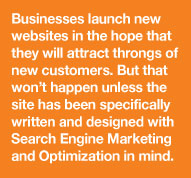 SEM is the practice of setting up and running a successful online presence while gaining maximum search engine visibility, i.e. the position of your site in the search engine results for certain keywords or phrases people enter when looking for information on products and services. Everything depends on how deep you are listed in these results. If you appear on the first couple of pages of results it’s very likely this visibility will bring a lot of traffic. If you are the 556th result it’s likely that people will stumble across you only by accident.
SEM is the practice of setting up and running a successful online presence while gaining maximum search engine visibility, i.e. the position of your site in the search engine results for certain keywords or phrases people enter when looking for information on products and services. Everything depends on how deep you are listed in these results. If you appear on the first couple of pages of results it’s very likely this visibility will bring a lot of traffic. If you are the 556th result it’s likely that people will stumble across you only by accident.
SEM programs usually consist of three main strategies: Search Engine Optimization, Paid Inclusion/Paid Advertising and Web Analytics.
Search Engine Optimization (SEO) is both art and science. By changing the content, HTML code and structure of your site SEO experts make your pages more compatible with the robots (spiders) search engines will send to read and rank them. The content of your web site and the way keywords are used in it determine whether or not the search robots will consider your content relevant and not just spam.
Paid Inclusion is different. You pay the search engine and it guarantees the inclusion of your site in the index. Many search engines also offer advanced pay-for-performance programs like the “sponsored results” that you often see at the top of your results page, and ads next to the organic results (pay-per-click ads) the most well known of these are GoogleAds.
A very important part of any SEM program is Web Analytics – tracking and analyzing visitor behavior on your site. You can find out the bounce rate for your landing pages – people who arrive at your landing page but leave almost immediately. By analyzing this data over time you’ll learn what’s working and what isn’t. Use this information to make improvements and raise traffic and conversion rates so that your site becomes a money maker, not just a business expense. Most web site hosting companies offer these analytics programs as an upgrade to your hosting plan; take advantage of them. Google™ Analytics is also a great way to track your site’s visitors and discover what keywords are working best for you.
See the section titled: Search Engine Marketing and Search Engine Optimization… Don’t Leave Home without Them for more information on this very important topic.
11. Automated Emails
Don’t miss out on a possible good prospect. Use auto-responders to trigger an automatic email message for people who came to your site but didn’t buy, abandoned a shopping cart, downloaded a white paper or filled out a survey. Contacting them when your site is still fresh in their mind, with content specific to their area of interest, may convert them into customers.
12. Multiple Landing Pages or Squeeze Pages
When people are coming to your site you want them to immediately see what is relevant to their needs. Creating specific landing pages for every ad, paid search term, direct mailer or email campaign you conduct will lead to more sales. Many campaigns fail to convert visitors into customers because they send them to an overly general landing page which does not meet the customer’s expectations of relevancy. Although unique to your campaign, your landing pages should include some branding elements and helpful navigation to explore the rest of your site so visitors will still understand who you are and what else you have to offer.
13. Set up a Follow-Up Program to Act on Leads and Track Web site Performance
Once you’ve developed your lead-generating web site you’ll need a systematic way to follow up on these prospects. You can start with auto-respond emails to any inquiries letting prospects know that you received their inquiry and will be following up appropriately. There are lead capture programs than can import information gathered from forms on your web site and add them to your database. Assign someone to either follow up on these new leads in a timely fashion or distribute them to your sales force. But don’t let those leads get stale.
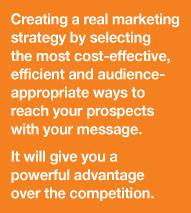 Conclusion
Conclusion
Your company’s web site is a critical aspect of the overall impression a prospect forms about your company. You not only need to be online but you also need to be doing the right things online for the right reasons; in other words – strategy. A well planned site with relevant content can outperform its deep-pocketed rivals who are less focused and savvy with their online presence. That’s a competitive advantage you can’t pass up.
What Makes a Great Brochure?
There is hardly a company out there that couldn’t make excellent use of a good product or service brochure. In fact, a well designed, informative brochure is often the cornerstone of a company’s marketing effort. They can be used for a single purpose, such as a leave-behind piece for sales calls, or for multiple uses. They can be mailed to prospects to spark interest, handed out at events and trade shows, mailed to fill information requests and more. A really good brochure can do a lot of heavy lifting for marketing and sales, the operative word being GOOD.
A marketing piece as important as this will be viewed carefully and will reflect the quality and value of your company’s products and services in the recipient’s mind. It can establish your credibility and professionalism, or destroy it. It can make the big sale, or break it. So, when it’s time for your company to produce a new brochure, make it a top priority to get it right the first time.
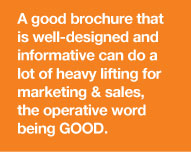 What goes into the design of a high-quality brochure?
What goes into the design of a high-quality brochure?
A quality brochure will use a combination of design, visuals, text and layout to create a look and feel that emphasizes your marketing objectives – introducing a new product, selling a service, creating brand awareness or soliciting donations. The objectives can vary as widely as the designs, what matters is that your brochure communicates effectively to your target audience. Often, having an outside firm write and design your brochure will help you avoid the trap of using industry jargon and acronyms. They will help you to view things from the prospect’s point of view instead of a salesperson’s.
When starting your brochure project begin by identifying your target audience. Who is this brochure aimed at? CEOs, housewives, human resources managers, affluent males over 50? Know your audience and speak to it, specifically. You may find that you have more than one distinct target audience you need to engage, such as a CEO and an IT manager. These two individuals would have very different concerns and levels of technical expertise. In that case think seriously about creating more than one brochure to appeal to each audience and address their specific questions and concerns. Remember, you need this heavy-hitting brochure to be effective. Creating more than one version may get you a higher ROI than producing just one, all-purpose brochure.
When you’ve determined who you are talking to select the most valuable benefit they derive from your product or service. You may want to do research here with past customers to determine that benefit, it’s not always what you think it will be. Your product may help a busy executive stay organized, but the real benefit to the customer may be the time your product saves him, or the freedom that organization gives him. If you take the time to identify why past customers bought your product it will pay off with new prospects. Then your new brochure can make use of text, pictures, colors and design to emphasize what that benefit will mean to them.
In the initial design process be sure to involve any high-level decision makers right from the start to get the buy-in you’ll need for approval. This will help you avoid costly redesigns and other changes at the end of a project when they are the most expensive and time consuming to make.
As we said in the beginning your brochure will do some heavy lifting for your sales and marketing departments, so don’t strain it too much. Avoid the temptation to overload your brochure with every fact, feature and detail of your offering. Give prospects the information they need to get excited about your product and persuade them to take the next step in your sales process. That could be calling to place an order, visiting a web site, setting up a sales appointment, or visiting a store location. Whatever your sales cycle calls for, make sure your brochure prominently asks your prospect to move forward – this is a Call To Action. That’s what you’re really after, so be sure to ask for it.
 A brochure allows you to leave a lasting impression on your prospects. That means a poorly executed brochure will actually do more harm than good, costing your company much more than the price of producing a high-quality piece in the first place. Be sure to check out the materials of the competition. The idea here is not to copy them, you always what to differentiate your company, but to make sure that your materials are as good or better than theirs. You will get the best ROI by using professional designers, photographers, copy writers, proofreaders and printers for your project. Help them gather all the information they need about your company, brand and product, then with guidance from you, let them do their stuff! The next time a prospect asks you for more information, you’ll be proud to present them with your impressive new brochure and you’ll know your well on your way to a new sale.
A brochure allows you to leave a lasting impression on your prospects. That means a poorly executed brochure will actually do more harm than good, costing your company much more than the price of producing a high-quality piece in the first place. Be sure to check out the materials of the competition. The idea here is not to copy them, you always what to differentiate your company, but to make sure that your materials are as good or better than theirs. You will get the best ROI by using professional designers, photographers, copy writers, proofreaders and printers for your project. Help them gather all the information they need about your company, brand and product, then with guidance from you, let them do their stuff! The next time a prospect asks you for more information, you’ll be proud to present them with your impressive new brochure and you’ll know your well on your way to a new sale.
The Logo – Your Company’s Visual Persona
The logo, that little doohickey that means so much. Your logo is an incredibly important part of your company’s marketing. Just think of everywhere it may appear – stationary, business cards, web sites, vehicles, signage, ads, brochures, packaging, billboards, uniforms and more. Although your logo isn’t your brand itself, it is the visual representation of it. People make conscious and unconscious judgments about your company in a split second based on how you choose to represent yourself and your company visually.
Logos are also referred to as identities, and with good reason. They are the visual persona of your company and are capable of conveying any message you want. Is your company humorous, trustworthy, fast, established and dependable, cutting-edge, high-end? A good logo will begin conveying your brand’s personality and attitude to prospects before they read a word of your copy. So, what would you like to say?
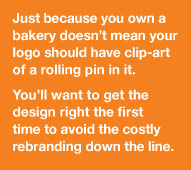 How can I tell a good logo from a bad one?
How can I tell a good logo from a bad one?
A good logo will represent you well now and in years to come. Longevity is an important aspect of logo design. A company’s logo should be unique, avoid imagery that is too literal. Just because you own a bakery doesn’t mean your logo should have a rolling pin in it. You may find such imagery very limiting as your company grows and changes over the years. You will be investing a lot of money in your logo over time. You may have letterhead, marketing materials, building signage, vehicle signage, uniforms and more that use your logo prominently. You’ll want to get it right the first time to avoid spending valuable marketing dollars re-branding down the line.
A logo needs to be well thought out and executed. A great logo will enhance your image and reinforce your branding message, directly contributing to the bottom line. A bad one will leave a lasting negative impression that will be difficult to overcome, and who needs another obstacle to overcome in today’s business climate?
So, how can you tell a good logo from a bad one? Evaluating a logo can be very subjective, but there are some qualities most good logos share. Start with the shapes involved, the cleaner and simpler the better. Even an all-type logo treatment is a shape at first glance. Overly-complicated, intricate logos are harder to recognize and remember. They are not effective in most signage applications. They are also harder to reproduce in some printing applications and will not reproduce well at small sizes – something all logos should be able to do. Simple, interesting designs will be the most effective. Avoid the latest design trends. The late 90’s was defined by the Swoosh Logo, everyone had to have some kind of arching swoosh in their logo. They became impossible to tell apart and differentiated no one. Right now the trend is fades, reflections and metallic looks. These logos will look dated in just a few years. The best logos appear to be timeless.

To properly evaluate a new logo you should first view it in black and white only. Color preferences are very subjective and shouldn’t be considered until the logo itself has been decided on. You could eliminate a great logo design just because you hate the color scheme. Once you have a strong, simple logo that possesses just the right attitude you want to convey, you can then feel confident moving on to color selection.
Your choice of corporate colors is just as important as the logo choice itself. Take the time to think ahead to all the current and likely future applications of your logo. You will probably want to use these colors, along with one or two complimentary ones, in all your marketing materials, your web site, vehicles, signage, etc. Making careful, informed decisions about color now will payoff in the future. You will most likely have to reproduce your corporate colors in spot colors (PMS), 4 color (CMYK), and web (RGB) applications. Picking colors that look good in all these situations will help you avoid potential headaches. Make sure your designer takes this into account.
The colors you select for your logo shouldn’t be based solely on personal preferences. Just because the V.P.’s wife hates green doesn’t mean that green isn’t the right color to convey your message. In order to overcome some of these personal color objections back up your choice with a little science. There are always trends in color that we see all around us, currently light blue and dark brown are favorites in home decor, just pick up a Pottery Barn catalog and you’ll see it. But, beyond trends, colors do have meanings associated with them, use those associations to your advantage.
Many companies find it helpful to have a memorable tagline or slogan that explains what their company does quickly and effectively when their name doesn’t make it instantly apparent. If you have a tagline make it part of your logo design project right from the start. Be sure to evaluate versions with and without the tagline to cover the various applications your logo will be used for.
Evaluating logo designs.
Choosing a new logo is an important process that deserves serious time and consideration. That being said, resist the temptation to overanalyze things. Keep the amount of people involved in the approval process to a minimum. The more people, the more opinions, suggestions and personal tastes will have to be taken into account. As the old saying goes “too many cooks spoil the broth”. Trying to please everyone will lead to over-compromising on the design which will result in a mediocre design everyone can live with, but no one really loves.
The best way to evaluate a logo is the way your customers will, with a quick glance at first. Avoid the temptation to stare at the designs and look for things to criticize. Feel free to get opinions from various people, but in the end, leave the final decision to a select few. When you’ve narrowed it down to one or two options mock-up some expected usages of your logo – ads, brochures, web sites, packaging. Seeing a logo design in context will help you evaluate its suitability for your company’s most important applications. Keep doing your best to remain objective when evaluating the logo. Remind the decision makers that it represents your company’s brand and objectives, not any one person, even if that person is the CEO (tread lightly, of course).
At the end of the process if the logo you’ve decided on is simple, clear, unique, functional for your applications and a good representation of your company’s persona, you’ve succeeded in navigating what can be a very stormy sea. Congratulations!
If you’ve decided it’s time to come up with a marketing strategy or plan that will grow your business, this article will help you get started.
Your marketing strategy is the way you’ll promote your products or services to the public, but not simply by running an ad. Creating a real strategy involves selecting the most cost-effective, efficient and audience-appropriate ways to reach your target prospects with your USP. It will give you a powerful advantage over the competition.
 Tactics are the elements you will use to execute your strategy. They can include: direct mail, print ads, PR, sales training, promotions, event sponsorships, holding seminars, email marketing, blogging, etc. You’ll use a combination of tactics to get your message out there and get your prospects to take the action you want such as; call, email, visit a store, download a brochure. Using more than one tactic to reach your audience is called Multi-Channel Marketing. Be sure to think of your audience when choosing tactics. Are they heavy computer users, radio listeners, commuters who pass billboards, coupon cutters, magazine readers? Use their habits to determine your tactics.
Tactics are the elements you will use to execute your strategy. They can include: direct mail, print ads, PR, sales training, promotions, event sponsorships, holding seminars, email marketing, blogging, etc. You’ll use a combination of tactics to get your message out there and get your prospects to take the action you want such as; call, email, visit a store, download a brochure. Using more than one tactic to reach your audience is called Multi-Channel Marketing. Be sure to think of your audience when choosing tactics. Are they heavy computer users, radio listeners, commuters who pass billboards, coupon cutters, magazine readers? Use their habits to determine your tactics.
12 Great Tips for Creating Your Strategy and Targeting Prospects
The two most important factors for small to medium size businesses to focus on are awareness and relevant differentiation (USP). Either one alone is ineffective; together they can be a powerhouse. These tips will help you create a strategy to achieve just that.
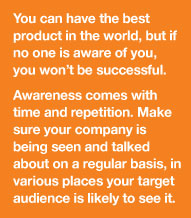 1. You can have the best product or service in the world, but if no one is aware of you, you won’t be successful.
1. You can have the best product or service in the world, but if no one is aware of you, you won’t be successful.
You can build awareness in a variety of ways: advertising, PR, newsletters, signage, direct mail, product samples. But, have you thought about producing a webinar, writing an article, sponsoring an event, branding your vehicle (a traveling billboard) or co-marketing with a complementary product? Be on the lookout for great promotional ideas and strategies used by other industries and see if you can adapt them to your advantage. Awareness comes with time and repetition, so the important thing is to keep at it. Make sure your company is being seen and talked about on a regular basis, in various places your target audience is likely to see it.
2. Once people are aware of your product, why should they choose it over all the others?
Awareness is great but it isn’t a magic bullet. People choose products that stand out in relevant and compelling ways. Your USP should be based on your knowledge of your prospects, their needs, problems, anxieties and expectations. Then you fill those needs, alleviate those anxieties and exceed those expectations. Try thinking like a customer. Jerold Panas said it well in his book Making the Case “People don’t go to a hardware store to buy a drill. They go to a hardware store to buy a drill because they need a hole.”
The key to a good USP is having a clear message that highlights your unique strengths and explains to prospects why your product is the best choice. You’ll find it more effective to tell them how your product or service solves their problem rather than just listing its features. Keep their perspective in mind, not yours. If you have a case study of how your product has solved the problems of others, even better! That can give you the credibility you need to make the sale.
3. How, exactly, do you get your message to the audience?
You’ll need to gain some knowledge about your prospects in order to reach them. You need to find out:
• Who the real decision-makers are (there may be more than one)
• What or who influences this target audience’s opinions
• What motivates him or her (speed, price, ego, style…)
• Where he or she gets information about your product category (trade magazines, internet sites, conferences…)
• The type of message they are likely to respond to: product samples, coupons, free evaluations, etc.
Use this knowledge to get the right message to prospects as efficiently as possible through the channels they use to gather information.
One way to determine all these facts is to hold an informal focus group with some of your current customers. This could be done by a phone, mail or email survey, or even by taking a select group of customers out to lunch, independently or as a group, to discuss these issues. Ask them where they get their information. For example, how did your prospects find out about some of the other products or services that they purchased recently? What web sites do they turn to for information? What keywords do they use to search for your type of product? (You’ll learn the importance of these keywords later). What trade associations do they belong to? What trade shows do they attend? What publications do they read regularly? You can rent these publications’ mailing lists, advertise on these web sites and visit or exhibit at these trade shows. This process of getting to know more about your existing clients will help you decide what methods to use to reach others like them. Don’t fall into the trap of assuming you know the answers if you haven’t actually asked your customers – they may surprise you.
4. Perform your own analysis of the competition.
It’s always a good idea to keep an eye on the competition. Start by reading local newspapers, trade journals, industry newsletters and visit web sites in your category to request information. Check who comes up in the top 30 results for Google® searches your potential clients are likely to use. You can learn a lot about your competition through their own advertising and PR. The idea here is not to copy them, but to know what you are up against.
5. Say it loud and say it often: multi-touch.
Once you know who you are selling to and what methods or tactics you will use to reach them, you’ll need to contact them at regular intervals using several channels (tactics). Frequency of contact (multi-touch) is important simply because people forget. It takes an average of 7-9 impressions to make an impact. Even when you have piqued their interest, if they don’t act immediately they will forget you in a week or two. Also, remember your prospects’ lives are constantly changing and their needs change unexpectedly. Just because they didn’t need your product or service two months ago doesn’t mean they don’t need it now. A multi-touch approach will build the brand awareness you need.
6. Say it here, say it there: multi-channel.
Be sure to use more than one method of contact or “channel” for your marketing. Your prospects are bound to have different preferences in how they like to receive information: email, print ads, direct mail, etc. Multiple channels allow you to communicate more often. The more often you interact with your prospect and the more relevant the information you provide, the more effective your campaign will be at rising above the clutter.
All of these communications need to make an offer and give your prospects a clear Call-to-Action. It doesn’t hurt to state it again and maybe again. It may sound obvious but be sure to tell them what you want them to do: call, order, visit a store, attend a webinar, doing so will raise your success rate.
Measure, refine and optimize your marketing channel mix. Spend wisely and calculate your cost per generated lead in each channel. Then stick with the most successful ones that produce the highest ROI. Implementing a good campaign will not only help your message reach the client at the correct time, but also extend the reach and improve the effectiveness of your sales force.
7. Anticipate objections.
Ask your salespeople (or yourself) what your prospect’s main objection to buying usually is – cost, fear of change, reliability – and address it up-front in your marketing. Then direct them to where they can find more information, request a brochure, visit your web site, etc. Many people won’t call a sales rep or visit a store early in the decision making process because they’re afraid of getting a hard sell. Give them a painless way to learn more.
8. Sometimes less is more.
No matter which channel you’re using, don’t overwhelm your prospect with too much information at once. Company history and mission statements can wait. Tell the prospect what problem your product or service will solve for them, what benefit they will derive, and use your USP to make you the obvious choice for them to make.
If you have several benefits to extol, try different campaigns emphasizing one benefit in each. You can still use the text of the piece to mention the additional benefits, but if you give equal emphasis to everything, nothing will stand out. Test to see what benefit gets a response from what target audience. Then you can target more effectively. Always ask the prospect for an action or response. You want them to call, mail or visit your web site to sign up for a newsletter or class, download a white paper, get more information or order your product. In any case, you now have a true sales lead to follow up on.
9. Make it easy for an interested prospect to contact you.
Always consistently display your brand’s logo, tagline, contact information and web site address at all customer touchpoints, from letterhead, business cards and emails to company vehicles, signage, ads, etc. Provide several ways to respond to your offer – call, visit our web site, mail a response card, let them choose what they prefer.
 10. Details matter! Professional design & copy writing enhance your strategy.
10. Details matter! Professional design & copy writing enhance your strategy.
It takes more than strategy to build a brand. You’ll need the right words and visuals as well. After putting all this thought and effort into your brand, strategy and marketing tactics, don’t fall into the trap of skimping on the execution. Design and copy are the translation of your brand and positioning to your audience. When done well they add meaning, they inform and persuade. They can engage the reader and evoke an emotional response. They are your brands voice. Poor design, copywriting and printing make you look like a fly-by-night operation they may want to stay clear of. Not the emotional response you intended.
Understanding and managing the creative process will give you a distinct advantage over the competition. Use it to achieve maximum brand-building results with each project. In order to get the most out of your designers and copywriters you need to involve them as early on in the process as possible. They have the experience to craft your message visually and verbally for maximum effect. If design is applied at the end of a project as an afterthought it will only serve as decoration that won’t add to the effectiveness of the piece. Design can be used to overcome communication problems, positioning problems, change perceptions and add differentiation if you make it an integral part of your strategy. Professional copywriting will give clarity and add interest to your message. It will help prospects identify with your brand and its message.
Both professional design and copywriting add value by providing distinctive content and credibility. Consider them a good investment of marketing dollars. These are strategic advantages – a way to stand out from all the other communications that are bombarding your prospects each day. It directly contributes to the bottom line.
Every marketing piece potential customers come in contact with must look professional and worthy of their time to view it. Having a professional appearance in all your marketing efforts will instill confidence and reinforce your brand’s reputation while giving you the most mileage out of every marketing dollar you spend.
Consistency is key. You will want to convey a consistent message, tone and visual look in all of your projects. Tying all these disparate materials together with design and a common voice creates brand harmony. This will turn your USP into a compelling visual as well as verbal message.
If all these task seems too daunting or expensive, redesign and rewrite the pieces one at a time, as time and budgets allow. But don’t miss out on this important aspect in implementing your new marketing strategy.
11. Performing a brand harmony audit–not as painful as it sounds.
There is an easy way to determine how consistent your current marketing materials are: perform an audit. Gather together all the materials your company puts in front of customers on one table. Find all the brochures, ads, direct mail pieces, catalogs, signage, web site, packaging, trade show exhibits, etc, (take photos or use printouts where necessary). Start sorting them by visual style. Is your company’s brand and USP coming through? Does one item relate to the next, or do they look completely different? Is the quality of the printed pieces up to your standards? Start reading the headlines and copy. Does the copy have the same tone or “voice” from piece to piece? You may find that some pieces are working well together, but maybe the signage or web site needs to be brought in line. Or, you may find a huge kaleidoscope of design styles and copy tones. In either case, you now know if you are using design, photography, copywriting and printing to their fullest potential and you can start producing materials that are based on your strategy.
Now that you are in auditing mode, why not take it a step further and compare your materials to the competition’s? Collect sales and marketing materials from your rivals and examine their web sites. It’s always a good idea to get on their direct mail and email lists. Do their materials look and sound alike? Are they all making the same claims? Don’t duplicate them, be different and beat their offer or benefit. Appeal to a niche not being well served or solve a problem they aren’t addressing. This is where your USP comes in. Use it to stand out from this crowd.
 Getting it done.
Getting it done.
Sales is a process of communication, not a one-time event. You’ve got to stay in front of your prospects through repeated contacts – whether that’s direct mail, sales calls, online press releases or, more likely, a combination of several tactics. That’s the essence of multi-channel, multi-touch marketing. Not just any contact will do. You need meaningful, informative, educational, persuasive contacts that address the issues and concerns of your prospects through your USP.
Smaller or newer businesses on tight budgets can approach these goals in stages as time and money allow. Start with your USP to set yourself apart. Define your goals, determine some tactics to achieve them, then start with your next marketing piece or activity. Take every opportunity to align your efforts with the new strategy until all your marketing efforts have brand harmony.
Regardless of whether you sell B2B or B2C, marketers are finding out that it’s all about people. Tap into your target audience as a person, not just a title or statistic. If you connect with them emotionally, by solving their problems and addressing their concerns, you’ll succeed.
Copyright © 2025 All Rights Reserved







